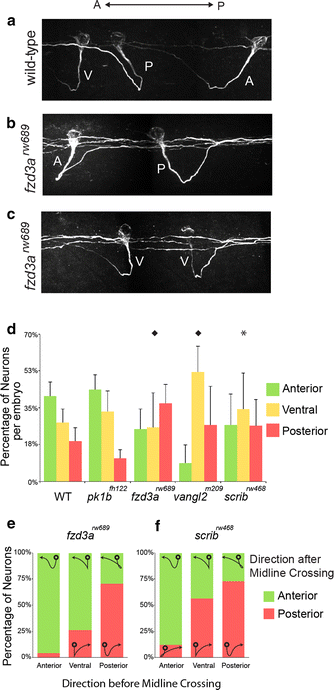Fig. 3
Pre-crossing commissural axon pathfinding is influenced by PCP components. a?c Confocal micrographs of CoPA axon pathfinding in WT and fzd3a rw689 embryos illustrating examples of CoPA axon trajectories. Anterior is to the left, dorsal is up. a CoPA axons have an anterior?posterior bias as they extend ventrally towards the midline. The majority of CoPA axons traverse ventro-anteriorly (A), straight ventrally (V), while a small proportion extend ventro-posteriorly (P). All CoPAs turn anteriorly by the time they have reached the contralateral spinal cord in wild-type embryos, b in fzd3a rw689 mutants, examples of pre-crossing CoPA axons that project ventro-posteriorly (P) and continue posteriorly after midline crossing, and a small number that project ventro-anteriorly before turning posteriorly after midline crossing, c in fzd3a rw689 mutants, pre-crossing CoPA axons that project straight ventrally (V) are more likely to make random A?P guidance as post-crossing fibers, d quantitation of the midline crossing points relative to cell body position among genotypes per embryo (*p < 0.05; ?p < 0.01; Pearson Chi square test). e, f distribution of post-crossing axon trajectory relative to the pre-crossing directional bias in fzd3a rw689 and scrib rw468 mutants. Superimposed on the graph are representations of the appearance of CoPA trajectories

